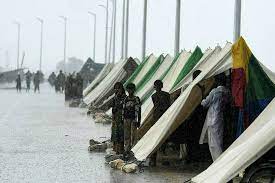November is challenging for rehabilitation phase.
ISLAMABAD – Over two weeks ago, UN Secretary-General Antonio Guterres and Prime Minister Shehbaz Sharif was seen welcoming a new-born baby named ‘Sailab Khan’ of a flood-affected displaced woman in a relief camp of Sindh.
Though this footage was considered as ‘ray of hope’ for homeless flood victims compelled to live in makeshift shelters, yet the difficulties of these homeless survivors are increasing due to unsatisfactory conditions in camps where cases of ‘dengue’ and ‘malaria’ are fast increasing.
The relief and rehabilitation is becoming an arduous challenge as winter is fast approaching in the country where shelter-less communities will definitely be required to prepare for the imminent cold weather. “Estimates indicate that at least 83,000 flood-affected women are pregnant and due to give birth in the coming months,” the initial figures United Nations Office for the Coordination of Humanitarian Affairs [UN-OCHA] reveals.
It may also be a record in the country’s history that 3,730 homeless pregnant women living in relief camps delivered recently their babies.
The climate crisis has put the pregnant and lactating women (PLW) and children under age five in the category of the most vulnerable at-risk groups.
The winter season in Pakistan usually comes with the start of November. The year the upcoming month of ‘November’ is comparatively under the discussion of political players on some other important topic.
The political figures are seemingly more concerned about significance of a new appointment or extension which is most likely to take place in this month of November.
Prime Minister Shehbaz Sharif, in the last week, at the platform of United Nations (UN) raised the voice for the flood victims of the country yet the relief and rehabilitation phase would be a challenge for the incumbent government, struggling to control inflation in the country.
The cases of ‘dengue’ and ‘malaria’ are also becoming a matter of concern in most parts of the country. Only Sindh [Most affected province due to floods] has witnessed 8,785 confirmed reported cases of dengue and 1,81,671 cases of Malaria, the cases may increase due to stagnant water receding very slowly in different areas near relief camps. The assessments , as per the OCHA, indicate that some 1,460 health facilities and their contents are damaged, further limiting people’s access to health services, while damage to 349 refrigerators and solar direct drive systems have reportedly resulted in disrupted vaccine cold chains. The alarming figures revealed the merciless flood waves have damaged and destroyed over two million houses. Around 23,900 schools, 1,460 health facilities and 13,000 km of roads have also reportedly been damaged.
Currently more than 5,000 schools are being used as temporary relief camps and some 7.9 million people are reportedly displaced as a result of the heavy rains and floods. Since 10 percent of the country’s healthcare institutions have been damaged by the floods, WHO representative to Pakistan Dr. Palitha Gunarathna Mahipala has reportedly shown much concern about pregnant women who among the hundreds of thousands of displaced people. Disaster and humanitarian experts viewed that the country’s ruling clique and the opposition has to jointly concentrate over the climate crisis leaving aside political differences, as this is a time to work together for the flood victims living miserably in relief camps.
Source: The Nation


